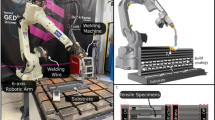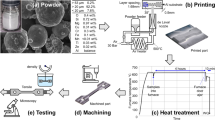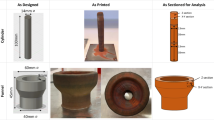Abstract
Cold spray additive manufacturing (CSAM) is relatively a new additive manufacturing technology that does not employ heat to achieve bonding between metal particles and the substrate. The CSAM process operates at a temperature lower than the melting temperature of the metal particle and the substrate. Hence, the constraints associated with high-temperature processing such as oxidation and phase change can be minimised, as well as the requirement of energy can be significantly reduced. This technology offers promising solutions for a wide range of applications in industries such as automotive, aerospace, and nuclear power generation. In this study, the effects of build orientation and post-build heat treatment on additively manufactured (AM) copper were investigated. Copper deposits were fabricated using a novel spraying system where stationary nozzle propels metal particles by compressed air onto a substrate clamped on a moving robot arm. The deposits were built in two different orientations (XY—0° and Z—90° to the build platform, respectively) and then mechanically tested in the as-deposited (AD), annealed at 400 °C (400 M), and sintered at 1000 °C (1000 M) conditions. The results strongly suggested that Z-build orientation samples had substantially lower inter-particle bonding strength compared with the XY-build direction samples due to the presence of porosity network. This pore network was created when the spray angle was abruptly changed from 90 to 45° orientation. The metallurgical bonding between particles improved with subsequent heat treatment. The 400 M samples consisted of recrystallised microstructure leading to an increase in tensile strength and ductility. Although the metallurgical bonding in the 1000 M samples was comparably better than the as-desposited samples, the formation of grossly large pores along grain boundaries acted as crack initiation sites, thereby resulting in very poor mechanical properties. This study has provided insights into the CSAM processing parameter selection and potential post-processing route to improve the mechanical properties of cold-sprayed copper parts.



















Similar content being viewed by others
Change history
10 September 2020
The original published article contained a mistake.
References
Papyrin A (2001) Cold spray technology. Adv Mater Processes 159:49
Sun W, Tan AWY, Wu K, Yin S, Yang X, Marinescu I, Liu E (2020) Post-process treatments on supersonic cold sprayed coatings: a review. Coatings 10(2)
Yin S, Cavaliere P, Aldwell B, Jenkins R, Liao H, Li W, Lupoi R (2018) Cold spray additive manufacturing and repair: fundamentals and applications. Additive Manuf 21:628–650
Raoelison RN, Xie Y, Sapanathan T, Planche MP, Kromer R, Costil S, Langlade C (2018) Cold gas dynamic spray technology: a comprehensive review of processing conditions for various technological developments till to date. Additive Manuf 19:134–159
Rahman Rashid RA, Barr CJ, Palanisamy S, Nazari KA, Orchowski N, Matthews N, Dargusch MS (2019) Effect of clad orientation on the mechanical properties of laser-clad repaired ultra-high strength 300 M steel. Surf Coat Technol 380
Ponnusamy P, Masood SH, Ruan D, Palanisamy S, Rashid R (2018) High strain rate dynamic behaviour of AlSi12 alloy processed by selective laser melting. Int J Adv Manuf Technol 97(1–4):1023–1035
Nazari KA, Rahman Rashid RA, Palanisamy S, Xia K, Dargusch MS (2018) A novel Ti-Fe composite coating deposited using laser cladding of low cost recycled nano-crystalline titanium powder. Mater Lett 229:301–304
Assadi H, Kreye H, Gärtner F, Klassen T (2016) Cold spraying—a materials perspective. Acta Mater 116:382–407
Kundu S, Jones R, Peng D, Matthews N, Alankar A, Raman SRK, Huang P (2020) Review of requirements for the durability and damage tolerance certification of additively manufactured aircraft structural parts and AM repairs. Mater 13(6)
Sinclair-Adamson R, Luzin V, Duguid A, Kannoorpatti K, Murray R (2020) Residual stress distributions in cold-sprayed copper 3D-printed parts. J Therm Spray Technol
Huang R, Sone M, Ma W, Fukanuma H (2015) The effects of heat treatment on the mechanical properties of cold-sprayed coatings. Surface Coatings Technol 261(C):278–288
Gärtner F, Stoltenhoff T, Voyer J, Kreye H, Riekehr S, Koçak M (2006) Mechanical properties of cold-sprayed and thermally sprayed copper coatings. Surf Coat Technol 200(24):6770–6782
Yin S, Jenkins R, Yan X, Lupoi R (2018) Microstructure and mechanical anisotropy of additively manufactured cold spray copper deposits. Mater Sci Eng A 734:67–76
Bu H, Yandouzi M, Lu C, Jodoin B (2012) Post-heat treatment effects on cold-sprayed aluminum coatings on AZ91D magnesium substrates. J Therm Spray Technol 21(3):731–739
Vo P, Irissou E, Legoux JG, Yue S (2013) Mechanical and microstructural characterization of cold-sprayed Ti-6Al-4V after heat treatment. J Therm Spray Technol 22(6):954–964
Levasseur D, Yue S, Brochu M (2012) Pressureless sintering of cold sprayed Inconel 718 deposit. Mater Sci Eng A 556:343–350
Rokni MR, Widener CA, Champagne VK, Crawford GA, Nutt SR (2017) The effects of heat treatment on 7075 Al cold spray deposits. Surface Coatings Technol 310:278–285
Li W, Huang C, Yu M, Liao H (2013) Investigation on mechanical property of annealed copper particles and cold sprayed copper coating by a micro-indentation testing. Mater Des 46:219–226
McDonald SA, Holzner C, Lauridsen EM, Reischig P, Merkle AP, Withers PJ (2017) Microstructural evolution during sintering of copper particles studied by laboratory diffraction contrast tomography (LabDCT). Sci Rep 7(1):5251
Zhu Y, Mimura K, Isshiki M (2002) Oxidation mechanism of copper at 623-1073 K. Mater Trans 43(9):2173–2176
Tannyan NJ, Plascencia G, Utigard TA (2002) High temperature oxidation of copper and copper aluminum alloys. Can Metall Q 41(2):213–218
Gong YS, Lee C, Yang CK (1995) Atomic force microscopy and Raman spectroscopy studies on the oxidation of Cu thin films. J Appl Phys 77(10):5422–5425
Liang J, Kishi N, Soga T, Jimbo T (2010) Cross-sectional characterization of cupric oxide nanowires grown by thermal oxidation of copper foils. Appl Surf Sci 257(1):62–66
Liu J, Cui H, Zhou X, Wu X, Zhang J (2012) Nanocrystalline copper coatings produced by cold spraying. Met Mater Int 18(1):121–128
Gan ZH (2004) Preparation and characterization of copper oxide thin films deposited by filtered cathodic vacuum arc. J Phys D Appl Phys 37(1):81–85
Winnicki M, Baszczuk A, Jasiorski M, Małachowska A (2017) Corrosion resistance of copper coatings deposited by cold spraying. J Therm Spray Technol 26(8):1935–1946
Li C-J, Li W-Y, Liao H (2006) Examination of the critical velocity for deposition of particles in cold spraying. J Therm Spray Technol 15(2):212–222
Ning X-J, Jang J-H, Kim H-J (2007) The effects of powder properties on in-flight particle velocity and deposition process during low pressure cold spray process. Appl Surf Sci 253(18):7449–7455
Zahiri SH, Fraser D, Gulizia S, Jahedi M (2006) Effect of processing conditions on porosity formation in cold gas dynamic spraying of copper. J Therm Spray Technol 15(3):422–430
Yin S, Wang X, Suo X, Liao H, Guo Z, Li W, Coddet C (2013) Deposition behavior of thermally softened copper particles in cold spraying. Acta Mater 61(14):5105–5118
Annealing and Recrystallization of Coppers, in: G.E. Totten (Ed.), Heat treating of nonferrous alloys, ASM International2016, p. 0
Eason PD, Kennett SC, Eden TJ, Krull I, Kowalski B, Jones JL (2012) In situ observation of microstrain relief in cold-sprayed bulk copper during thermal annealing. Scr Mater 67(9):791–794
Zhang W, Li SY, Yang ZX, Mao Y, Xu SY (2015) Microstructure evolution and mechanical properties of copper bonding wire during continuous annealing. Materials Research Innovations 19(sup4):S225–S229
Li W-Y, Li C-J, Liao H (2006) Effect of annealing treatment on the microstructure and properties of cold-sprayed Cu coating. J Therm Spray Technol 15(2):206–211
Boyle CH, Meguid SA (2015) Mechanical performance of integrally bonded copper coatings for the long term disposal of used nuclear fuel. Nucl Eng Des 293:403–412
McCune R, Donlon W, Popoola O, Cartwright E (2000) Characterization of copper layers produced by cold gas-dynamic spraying. J Therm Spray Technol 9(1):73–82
Kumar A, Bai Y, Eklund A, Williams CB (2017) Effects of hot Isostatic pressing on copper parts fabricated via binder jetting. Procedia Manuf 10:935–944
Acknowledgements
The authors would like to acknowledge the Victorian Government Future Industries Sector Growth program, along with the industry, SPEE3D, in acquiring LIGHTSPEE3D. The paper has been written in line with the intellectual property rights granted to research partners from the original DMTC project. The authors would like to thank Mr. Mohammad Imran Kaleemi, Mr. Michael Culton, and Ms. Yeannette Lizama for their technical support during this research study.
Funding
This research project was supported by the Defence Materials Technology Centre (DMTC) Limited (Australia).
Author information
Authors and Affiliations
Corresponding author
Additional information
Publisher’s note
Springer Nature remains neutral with regard to jurisdictional claims in published maps and institutional affiliations.
The original version of this article was revised: The author name “S. Palasinamy” should be “S. Palanisamy”
Rights and permissions
About this article
Cite this article
Hutasoit, N., Rashid, R.A.R., Palanisamy, S. et al. Effect of build orientation and post-build heat treatment on the mechanical properties of cold spray additively manufactured copper parts. Int J Adv Manuf Technol 110, 2341–2357 (2020). https://doi.org/10.1007/s00170-020-06010-5
Received:
Accepted:
Published:
Issue Date:
DOI: https://doi.org/10.1007/s00170-020-06010-5




